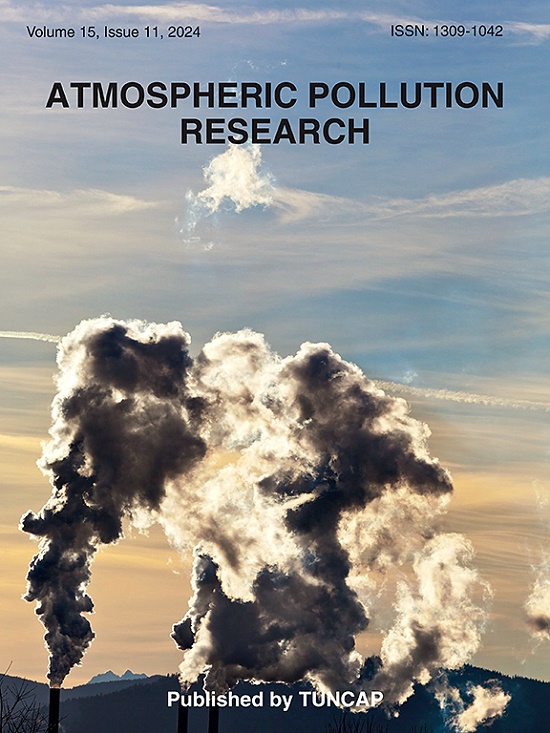Sensitivity of AERMOD (V21112) RLINEXT dispersion model outputs by source type to variability in single noise barrier height and separation distance
IF 3.9
3区 环境科学与生态学
Q2 ENVIRONMENTAL SCIENCES
引用次数: 0
Abstract
The U.S. Environmental Protection Agency (USEPA) introduced the RLINEXT modeling feature in the latest versions of AERMOD (since version v21112) to predict traffic-induced pollutant concentration when noise barriers are present. The research presented in this paper explores the impacts of noise barrier characteristics on AERMOD-predicted concentrations. The research finds that because AERMOD can currently only attach one barrier to each road side, and because that barrier only impacts the source to which it is attached, it is also important to split links so that they properly pair with barriers. Given the sensitivity of AERMOD-predicted concentrations to barrier characteristics (i.e., barrier heights and distances to roadway), the research also concludes that barriers must be appropriately matched with input links. This study investigated the sensitivity of CO concentration predicted by the latest AERMOD under various noise barrier conditions (barrier heights and distances between road and barrier) and meteorological conditions (wind directions and wind speeds). The results indicate that ground-level concentration of downwind receptors decreases with increased barrier heights, and that distant barriers have less of an impact on predicted concentrations. This study also explored the impact of noise barrier on both horizontal and vertical concentration profiles, indicating that concentrations rise behind the barrier as plumes are predicted to loft over the barrier. The sensitivity analysis associated with splitting roadway links to match with barriers indicated an impact on predicted concentration for certain receptors of up to 10%, but the overall the impact on maximum concentrations was marginal.
按声源类型划分的 AERMOD (V21112) RLINEXT 扩散模式输出结果对单一噪声屏障高度和间隔距离变化的敏感性
美国环境保护局 (USEPA) 在最新版本的 AERMOD(自 v21112 版起)中引入了 RLINEXT 建模功能,用于预测存在隔音屏障时交通引起的污染物浓度。本文介绍的研究探讨了隔音屏障特性对 AERMOD 预测浓度的影响。研究发现,由于 AERMOD 目前只能在每条路的一侧附加一个隔音屏障,而隔音屏障只对其附加的声源产生影响,因此还必须拆分链接,使其与隔音屏障正确配对。鉴于 AERMOD 预测浓度对障碍物特征(即障碍物高度和与道路的距离)的敏感性,研究还得出结论,障碍物必须与输入链接适当匹配。本研究调查了在各种噪声屏障条件(屏障高度和道路与屏障之间的距离)和气象条件(风向和风速)下,最新 AERMOD 预测的一氧化碳浓度的敏感性。结果表明,下风向受体的地面浓度随着隔音屏障高度的增加而降低,远处的隔音屏障对预测浓度的影响较小。这项研究还探讨了噪声屏障对水平和垂直浓度剖面的影响,结果表明,由于预测羽流会飘过屏障,因此屏障后面的浓度会升高。与分割道路连接以与隔声屏障相匹配相关的敏感性分析表明,对某些受体的预测浓度的影响高达 10%,但总体而言,对最大浓度的影响微乎其微。
本文章由计算机程序翻译,如有差异,请以英文原文为准。
求助全文
约1分钟内获得全文
求助全文
来源期刊

Atmospheric Pollution Research
ENVIRONMENTAL SCIENCES-
CiteScore
8.30
自引率
6.70%
发文量
256
审稿时长
36 days
期刊介绍:
Atmospheric Pollution Research (APR) is an international journal designed for the publication of articles on air pollution. Papers should present novel experimental results, theory and modeling of air pollution on local, regional, or global scales. Areas covered are research on inorganic, organic, and persistent organic air pollutants, air quality monitoring, air quality management, atmospheric dispersion and transport, air-surface (soil, water, and vegetation) exchange of pollutants, dry and wet deposition, indoor air quality, exposure assessment, health effects, satellite measurements, natural emissions, atmospheric chemistry, greenhouse gases, and effects on climate change.
 求助内容:
求助内容: 应助结果提醒方式:
应助结果提醒方式:


